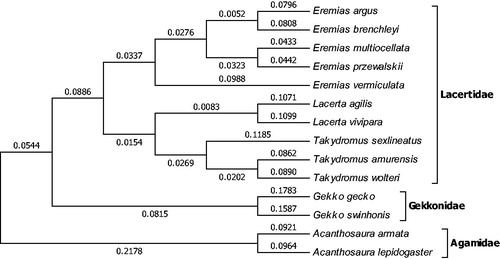Abstract
The complete mitogenome sequence of Takydromus amurensis (Squamata: Lacertidae) is determined using long PCR for the first time in this study. It is a circular molecule of 17 333 bp in length (GenBank accession number: KU641018). Similar to the most other lizards, the complete mtDNA sequence of T. amurensis contained two rRNA genes (12S rRNA and 16S rRNA), 22 tRNA genes, 13 protein-coding genes (PCGs) and a control region (D-loop). The nucleotide composition was 31.23% A, 26.06% C, 13.91% G and 28.8% T. Mitochondrial genomes analyses based on NJ method yield phylogenetic trees, including 14 reported lizards belonging to three families (Lacertidae, Gekkonidae and Agamidae). These molecular data presented here provide a useful tool for systematic analyses of genus Takydromus.
The interrelationships and phylogeny evolution of East Asian grass lizards of the genus Takydromus (Lacertidae) have been reported with morphological characters and DNA sequences (Arnold Citation1997; Lin et al. Citation2002; Ota et al. Citation2002; Lin et al. Citation2006). In recent years, with the development of mitochondrial DNA (mtDNA) molecular marker technology, the complete mitochondrial genome of T. wolteri and T. sexlineatus is sequenced (Yu & Ji Citation2013; Qin et al. Citation2015). In order to perform a systematic analysis with these molecular data, the complete mitochondrial genome of the Heilongjiang grass lizard T. amurensis is determined for the first time with a muscle sample using a primer walking strategy and the long and accurate PCR in this paper. This small multiple-clutched oviparous insectivorous lizard is mainly found in Northeast China, Russia and Korean Peninsula (Zhao et al. Citation1999). The specimen was collected from Changbai Mountain in Jilin Province of China (42°36′18.5″, 127°50′44.8″E) and was stored in Zoological and Botanical Specimen Museum of Harbin Normal University (its accession number is HRB1506080).
The obtained complete sequence of T. amurensis is 17 333 bp long and contains two rRNA genes (12S rRNA and 16S rRNA), 22 tRNA genes, 13 protein-coding genes (PCGs) and a control region (CR; D-loop). This structural arrangement corresponds to that of the typical lizard mitogenome (Boore Citation1999; Böhme et al. Citation2007). The nucleotide composition is 31.23% A, 26.06% C, 13.91% G and 28.8% T. The accurate annotated mitochondrial genome sequence was submitted to GenBank with accession number KU641018.
Within the mitochondrial genome of T. amurensis, there are 11 reading frame overlaps (share 1–10 nucleotides) and nine intergenic spacers (range from 1 to 3 bp). Nine genes (ND6 and eight tRNA genes) are encoded on the light strand (L-strand) and the remainders are on the heavy strand (H-strand). All the 13 PCGs begin with ATG as start codon. ND1, ATP8, ATP6, ND3, ND4L, ND5 and CYTB genes are terminated with TAA as stop codon; COII, COIII and ND4 end with a single stop nucleotide T, ND2 ends with TAG, COI ends with AGG, and ND6 ends with AGA. The 22 tRNA genes with the size ranging from 64 to 73 bp are interspersed along the whole genome. The sequence length of the 12S and 16S rRNA is 950 and 1531 bp, respectively, D-loop region is 1953 bp. In the WANCY cluster of tRNA genes, a 26 bp sequence is considered as the putative L-strand replication origin, OL.
Mitochondrial genomes analyses based on MP, ML and NJ yielded identical phylogenetic trees, including 14 reported lizards belonging to three families (Lacertidae, Gekkonidae and Agamidae) (). It appeared that T. amurensis and T. wolteri formed a monophyletic group as they are similar in the morphology and distribution (Zhao et al. Citation1999), they belong to the same group as T. sexlineatus. This study will facilitate the further research on comparing the genetic structure of the related species such as T. sylvaticus (Tang et al. Citation2014) and systematic analyses of the genus Takydromus.
Figure 1. Phylogenetic tree generated using the neighbour-joining method based on complete mitochondrial genomes of some species of Lacertilia. Eremias argus (NC_016755), Eremias brenchleyi (NC_011764), Eremias multiocellata (NC_025304), Eremias przewalskii (NC_0259294), Eremias vermiculata (NC_025320), Lacerta agilis (KC990830), Lacerta vivipara (NC_026867), Takydromus sexlineatus (NC_022703), Takydromus amurensis (KU641018), Takydromus wolteri (NC_018777), Gekko gecko (NC_007627), Gekko swinhonis (NC_018050), Acanthosaura armata (NC_014175) and Acanthosaura lepidogaster (KR092427).

Disclosure statement
The authors report no conflicts of interest. The authors alone are responsible for the content and writing of the paper.
Funding information
This work was supported by National Natural Science Foundation of China (#31172079).
References
- Arnold E. 1997. Interrelationships and evolution of the east Asian grass lizards, Takydromus (Squamata: Lacertidae). Zool J Linn Soc. 119:267–296.
- Böhme MU, Fritzsch G, Tippmann A, Schlegel M, Berendonk TU. 2007. The complete mitochondrial genome of the green lizard Lacerta viridis viridis (Reptilia: Lacertidae) and its phylogenetic position within squamate reptiles. Gene. 394:69–77.
- Boore JL. 1999. Animal mitochondrial genomes. Nucleic Acids Res. 27:1767–1780.
- Lin SM, Chen CA, Lue KY. 2002. Molecular phylogeny and biogeography of the grass lizards genus Takydromus (Reptilia: Lacertidae) of East Asia. Mol Phylogenet Evol. 22:276–288.
- Lin SM, Wang CJ, Hsu YC, Lue KY, Li SH. 2006. Isolation and characterization of 12 tetra-repeated microsatellite loci from the Formosan grass lizard (Takydromus formosanus). Mol Ecol Note. 6:57–59.
- Ota H, Honda M, Chen SL, Hikida T, Panha S, Oh HS, Matsui M. 2002. Phylogenetic relationships, taxonomy, character evolution and biogeography of the lacertid lizards of the genus Takydromus (Reptilia: Squamata): a molecular perspective. Biol J Linn Soc. 76:493–509.
- Qin PS, Zeng DL, Hou LX, Yang XW, Qin XM. 2015. Complete mitochondrial genome of Takydromus sexlineatus (Squamata:Lacertidae). Mitochondr DNA. 26:465–466.
- Tang XS, Chen JM, Huang S. 2014. Mitochondrial genome of the Chung-an ground lizard Takydromus sylvaticus (Reptilia: Lacertidae). Mitochondrial DNA. 25:319–320.
- Yu DN, Ji X. 2013. The complete mitochondrial genome of Takydromus wolteri (Squamata: Lacertidae). Mitochondrial DNA. 26:3–5.
- Zhao EM, Zhao KT, Zhou KY. 1999. Fauna Sinica, Series Vertebrata Reptilia, 2: Squamata, Lacertilia. Beijing: Science Press (in Chinese).
